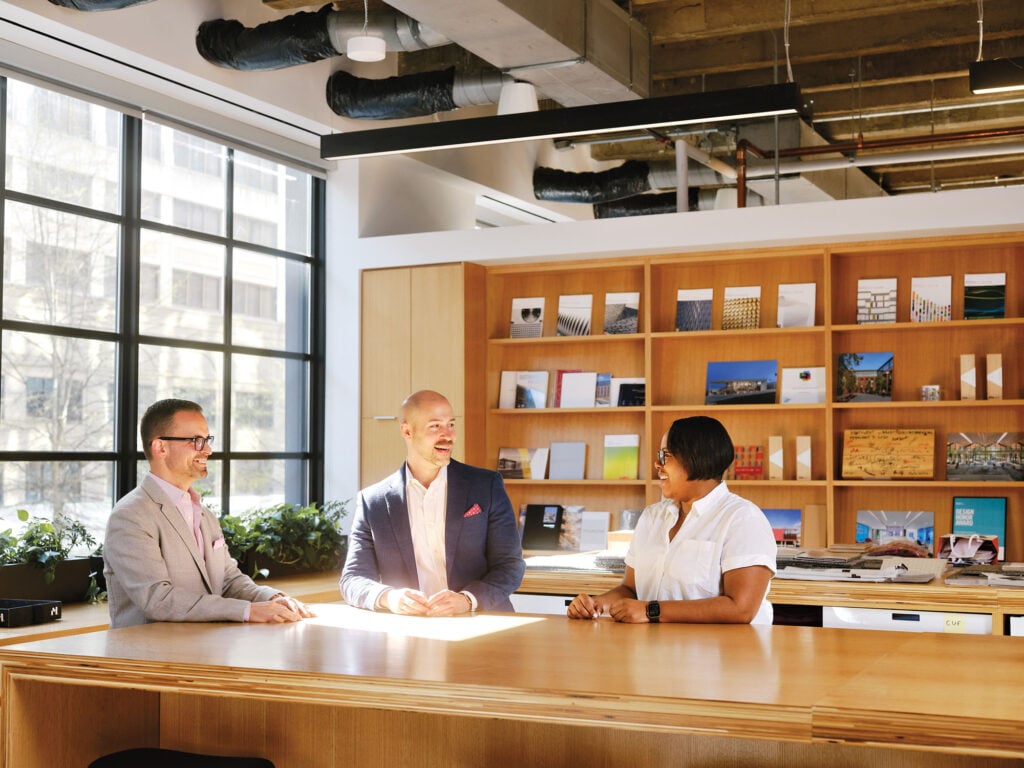
June 1, 2022
Specify Hot List: Perkins&Will, D.C.
“I think there’s a misconception that the design of interior spaces won’t have much of an impact on climate change. That’s a hundred percent not true.”
Jon Penndorf

It’s in this firm-wide ecosystem that “going back 10, 12 years ago, we signed on to the American Institute of Architects’ 2030 Challenge and have publicly reported performance data on our projects for over a decade,” says Cordell.
“The firm as a whole is starting to look at embodied carbon and carbon analysis in general as part of our commitment to living design,” adds Jon Penndorf, senior associate and project manager for the Washington, D.C., office.

Still, tools are only as effective as their users. “When we published our goals we were doing it as an individual office,” Penndorf says, underscoring his team’s special commitment. The D.C. team is especially motivated (meaning it’s “aggressively” looking to increase its sustainable performance) because it has a large commercial interiors studio, and U.S. commercial interiors are infamous for their frequent renovation cycles.
“For most of our interior design projects–and for interior projects in general– they have short life cycles because tenant lease terms are usually five to 15 years,” says Brittany McNairy, a senior technical coordinator in the D.C. office. “As a result of that, we’re evaluating the demolition of interior spaces and projects that we’re working on. We’re looking at those projects and searching for opportunities to salvage and repurpose materials.”


Construction and material fabrication account for 25 percent of the embodied carbon of a building’s lifetime carbon emissions, so the team is constantly searching for opportunities to reuse doors, ceiling tiles, ceiling grids, and millwork, McNairy says.
According to Cordell, they’re also taking steps to investigate what happens at the end of a product’s useful life. “We’re having conversations with manufacturers about take-back programs for things like carpet and tile, where manufacturers reclaim those [materials] so they can recycle and reuse them.” To avoid adhesives and glues that undermine the reuse of partitions and ceiling systems, the designers are collaborating with millworkers to detail connections differently and assemble those elements with mechanical fasteners instead, he explains.

Care in selecting new materials is also a large part of the net-zero embodied carbon mission, so the team is giving priority to products with a high level of environmental transparency.
To grasp the feasibility of these processes, P&W designers turned their new D.C. workspace into a case study. Located in a warehouse building that was once John F. Kennedy’s campaign headquarters, the 14,300-square-foot space is flexible and adaptive for a 21st-century office. Using a thermal gradient model, height-adjustable desks, and free-address desking, the design encourages employees to choose seating each day based on their individual comfort and needs.
“Our goal was to design a space that serves as an embodiment of our environmental stewardship.”
Brittany McNairy
“Our goal was to design a new space that serves as an embodiment of our environmental stewardship as well as demonstrating our leadership in living design,” McNairy says. For that purpose, they pursued certifications for the workplace from multiple third-party rating systems, including WELL, LEED, the Living Building Challenge, and Fitwel.
The design formula was clear and easy to reproduce: They avoided Red List materials of concern, eschewed PVC laminate in favor of large-format porcelain tile, and specified wood for its warmth and ability to sequester carbon. In the end, the firm saw a 56 percent net reduction in embodied carbon, without compromising on design or budget.
“One of the big takeaways from [our own space] was the importance of pursuing multiple third-party rating systems,” McNairy explains. “We were able to understand the synergies of those systems, as well as where there were conflicts between them. It required us to prioritize our design decisions.”
It also confirmed for the team that they can dispel long-held misunderstandings among clients and the commercial interiors industry overall.
“When you look at the life span of an office building, you look at the embodied carbon of the building itself, which is built once versus all of those interior spaces that are renewed every five or ten years. The interior build-out represents far more embodied carbon than the original building,” Penndorf says. “I think there’s a misconception that the design of interior spaces won’t have much of an impact on climate change. That’s a hundred percent not true.”
Would you like to comment on this article? Send your thoughts to: [email protected]
Related
Profiles
Inside Three SoCal Design Workshops Where Craft and Sustainability Meet
With a vertically integrated approach, RAD furniture, Cerno, and Emblem are making design more durable, adaptable, and resource conscious.
Products
Windows and Doors for Better Views—and Performance
The latest window and door systems balance sleek design with sustainability and high performance.
Profiles
BLDUS Brings a ‘Farm-to-Shelter’ Approach to American Design
The Washington D.C.–based firm BLDUS is imagining a new American vernacular through natural materials and thoughtful placemaking.












